
|
![]()
Greatest Films of the 1940s
1940 | 1941 | 1942 | 1943 | 1944 | 1945 | 1946 | 1947 | 1948 | 1949
Title Screen Film Genre(s), Title, Year, (Country), Length, Director, Description 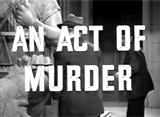



An Act of Murder (1948) (aka Live Today for Tomorrow, or I Stand Accused), 91 minutes, D: Michael Gordon
The film's screenplay was adapted from Ernst Lothar's novel "The Mills of God" - it was a poignant, film-noirish melodrama about a controversial topic. Strict and unyielding small town Pennsylvania Judge Calvin Cooke (Fredric March) was known as "Old Man Maximum" for his reputation of following "the letter of the law" and delivering harsh sentences. He was devoted to wife Catherine (or "Cathy") (Florence Eldridge) and their volatile law student daughter Ellie Cooke (Geraldine Brooks). However, he did not approve of the relationship Ellie was having with young defense attorney David Douglas (Edmond O'Brien), who interpreted the law more liberally. Cooke's wife had increasing symptoms of blurred vision and frequent severe headaches. The family physician Doctor Walter Morrison (Stanley Ridges) diagnosed a terminal illness: a fatal brain tumor. He kept the news secret from Cathy but not from Calvin. During a second honeymoon trip (a weekend outing) with Calvin, Cathy discovered her prescription for toxic Demarine pain pills and the doctor's description of her illness (hidden in her husband's suitcase), but did not reveal what she had found. During the trip home by car, after stopping at a roadside gas station garage and cafe, Cathy collapsed. The Cooke's car crashed through an embankment on a mountainous road - and Cathy was killed, while Calvin was injured, and afterwards, he had to walk with a cane). After the crash, he implored the DA to indict him for murdering his wife - he claimed he intentionally drove off the road during the raging storm to cause the accident - and set up the mercy killing (or euthanasia) to relieve his wife's suffering. The film's tagline summarized the judicial proceedings in the film: "MERCY or MURDER? Can you condemn this man?" Acting as his own lawyer, Calvin pleaded guilty of murder before Judge Ogden (John McIntire), who appointed (under Cooke's protest) David Douglas as Cooke's lawyer at the sentencing hearing. Douglas ordered an autopsy - the results revealed that Cathy had died of a pain-killer drug overdose before the crash. Witnesses corroborated her story that she filled the prescription at the hotel with a pharmacist, and took the pills at the cafe before the crash. The judge dismissed the charges, ruling that Cooke was legally innocent, but his moral intentions were guilty. He was saved by the unforgiving legal code that declared she was already dead. Cooke had a change of heart about his judicial attitudes, promising to be more lenient, compassionate, and respectful of moral circumstances and personal situations during trials - he was finally in agreement with Douglas and his daughter.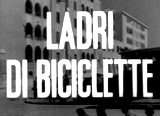

The Bicycle Thief (1948, It.) (aka Ladri di Biciclette, or Bicycle Thieves), 98 minutes, D: Vittorio De Sica
Director Vittorio De Sica's Best Foreign Film Oscar winner (before the category was officially created) was an all-time classic Neo-realism film (with an amateur, unprofessional cast filmed in non-studio locations). The humanistic film's simple, tragic, yet compelling story, based on Luigi Bartolini's novel, was about the desperate economic plight of a prototypical Italian after the war. In post WWII Italy during a time of unemployment and devastation, the bicycle of an impoverished, working-class family man, Antonio Ricci (Lamberto Maggiorani) was stolen in the ruined city of Rome while he was hanging up a film poster of Rita Hayworth on a ladder, on the first day of his job. His wife Maria Ricci (Lianella Carell) had sold their linen sheets for 7,500 lira to a pawnshop, allowing him to buy back his own bicycle for 6,500, which he had pawned weeks earlier for money to buy food. The victimized man's very job and survival were dependent on this simple form of transportation. The anguished, panic-stricken father and his son Bruno Ricci (Enzo Staiola) searched for the bike for a full week, but couldn't locate it, and the police wouldn't help them. Along the way, Antonio encountered injustice and apathy. From beginning to end, his small but fierce son Bruno was his companion, with whom he learned what real desperation could be. Feeling defeated, the father stole another bicycle but was immediately apprehended and humiliated in front of his son, although he was released.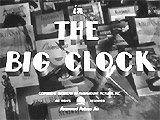


The Big Clock (1948), 95 minutes, D: John Farrow
Director John Farrow's film noirish suspenseful thriller was later updated as the spy thriller No Way Out (1987) with Kevin Costner. In the opening scene, 1940's New York City media executive and Crimeways weekly magazine journalist-editor George Stroud (Ray Milland) was hiding inside his company's gigantic $600,000 privately-owned corporate clock in the Janoth Publications building's lobby (which synchronized with all other clocks in the entire building and in secondary printing plants and dozens of other foreign bureaus). The editor-in-chief found himself in a symbolic race against time to clear his own name (as he narrated what had happened to him). Married man Stroud was in the midst of planning to go on a long-postponed honeymoon trip to Wheeling, WV with his wife Georgette (Maureen O'Sullivan) and son, but found himself keeping late company in a bar with blonde Pauline York (Rita Johnson), the mistress of his clock-obsessed, ruthless and detestable homosexual boss Earl Janoth (Charles Laughton), the powerful publishing tycoon of NYC's Crimeways Magazine; he and Pauline (who was extorting money from Janoth) discussed how she might blackmail Janoth. They also bought a sundial and an abstract painting in an art shop during their evening together. This prelude led to a flashback 36 hours earlier when Stroud was implicated in the murder of Pauline. Both Stroud and Pauline were drunk when they returned to Pauline's apartment late that night. Before entering Pauline's apartment and killing her, Janoth noticed someone else who had just left Pauline's apartment just as he arrived, but did not see the man's face. Janoth pressured Pauline to identify her presumed other lover - she elusively claimed that the man's name was "Jefferson Randolph" to protect Stroud. The jealous Janoth killed Pauline after accusing her of having another lover - she snapped back that he was a "cheap imitation Napoleon" and called him "disgusting...flabby." He struck her in the head with the phallic-shaped, heavy metal sundial - and there was a contorted closeup of Janoth's grotesque face with a twitching upper lip. To cover up his crime, Janoth cleverly planned to blame the murder on the other man. Janoth confessed his crime to his right-hand man Steve Hagen (George Macready), and had him cover up all evidence of the murder (including setting Pauline's clock - broken at the time of her death - ahead one hour), to frame the other man for the killing. The bulk of the film was the ensuing cat-and-mouse game by Stroud who was enlisted by Janoth to investigate the case and find the killer (who was witnessed accompanying Pauline during the evening by many individuals). Stroud feared that his investigation would lead to only one man - himself! He realized that all the clues pointed to himself as the prime suspect, so he desperately attempted to steer the manhunt away from himself, and find information to incriminate Janoth by using a method of "irrelevant clues." At the film's end in a taut confrontational scene, the framed Stroud accused Steve Hagen of being the killer in order to smoke out Janoth - causing a raging Janoth to shoot Hagen (after he confessed: "Janoth killed Pauline"). Then, Janoth fell to his death down his building's empty elevator shaft during his attempted escape.

Easter Parade (1948), 103 minutes, D: Charles Walters
This memorable and happy MGM film, a perennial holiday favorite, was an Academy Award winner for Best Musical Score, with a number of classic songs and dance sequences - and a Pygmalion-plot involving many romantic complications. It was set in 1912, with a storyline about how vaudeville dancer Don Hewes (an older Fred Astaire, coming out of retirement, and a replacement for injured Gene Kelly) promised to turn an aspiring, naive chorus-girl protege Hannah Brown (Judy Garland), a bar waitress, into a star. He had recently been dropped by his long-time tap-dancing partner Nadine Hale (Ann Miller, replacing Cyd Charisse) (and romantic interest) who decided to go solo on Broadway in a Ziegfeld Follies show (the Follies of 1912). Though Don regretted the loss of Nadine, he sought jealous revenge against her. Hannah worked hard to capture Don's approval - and his heart. At the same time, Nadine was aggressively pursuing Don's best friend Jonathan Harrow III (Peter Lawford), who was showing more interest in Hannah, while she was silently pining for Don. This was Astaire's and Garland's first and only teaming together, and producer Arthur Freed's fifth collaboration with composer Irving Berlin. It was filled with seventeen Irving Berlin songs, including the dance number It Only Happens When I Dance With You between Astaire and partner Ann Miller in a hotel suite, Miller's flashy and strong song/dance rendition of Shakin' the Blues Away, Astaire's slow-motion version of Steppin' Out With My Baby, the gleeful Astaire/Garland comic show-stopping duet (We're) A Couple of Swells while dressed as lovable tramps, the opening rendition of Happy Easter, Astaire's creative dance sequence Drum Crazy in a toy store, the marvelous vaudeville montage sequence with Astaire and Garland entitled When That Midnight Choo-Choo Leaves for Alabam, and the closing performance of the title number Easter Parade, staged as a Fifth Avenue parade.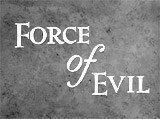


Force of Evil (1948), 78 minutes, D: Abraham Polonsky
Co-writer/director Abraham Polonsky's first directed film as a screenwriter was based on Ira Wolfert's novel Tucker's People. It was an expressionistic, politically-subversive and dark work, and an uncompromising post-war film noir that was narrated and told in documentary style. It was one of the few Hollywood films at the time with a devastating critique of capitalism. [Note: Shortly later, Polonsky was blacklisted for being an uncooperative witness before HUAC in 1951, and didn't direct any more feature films for almost 21 years.] The cynical gangster crime film about corruption and attempted redemption revolved around young, successful, corrupt Wall Street mob attorney Joe Morse (John Garfield in probably his finest role). In his opening voice-over (during a high-angle camera view of towering monolothic skyscrapers surrounding and overwhelming Trinity Church near Wall Street), he spoke: "This is Wall Street and today was important because tomorrow, July Fourth, I intended to make my first million dollars, an exciting day in any man's life. Temporarily, the enterprise was slightly illegal. You see, I was the lawyer for the numbers racket....The suckers bet on any combination of three numbers, selected from the totals bet at some racetrack that day. Twenty million bettors a day in the United States - annual income of cheap crooks and racketeers over $100,000,000 dollars. It seemed a shame so much good money to go to waste in other people's pockets." Due to corrupt dealings with numbers racketeer-client and slimy crime boss Ben Tucker (Roy Roberts) who wanted to control the numbers racket, Morse was on the verge of easy money - making millions through a race-track betting scam-fix so that the winning lottery number on July 4th would be 776. Because so many superstitious bettors would make that bet, it would cause the many small numbers banks to go bankrupt and allow crooked Tucker to emerge as the city's #1 racketeer. Citywide, racketeers were up against Link Hall (Arthur O'Connell), the city's new special prosecutor, who was on a crusade to eliminate numbers runners, and was tapping telephones. However, as a self-proclaimed lawyer for the numbers racket, Joe was interested in becoming wealthy by making the racketeering legal for his Tucker Enterprises, Inc. client: "We've got a big retainer to change the numbers racket into a legal lottery." In this Cain and Abel tale, Joe's honest, kindly yet estranged and stubborn older brother Leo Morse (Thomas Gomez) with a weak heart remained in the Lower East Side slum neighborhood where they had grown up, maintaining a local "small numbers bank," and refusing to join the corrupt dealings of his younger brother. Leo accused Joe of blackmail and refused a proposed alliance deal: ("I'll give you my answer, calmly and sensibly. My final answer. My final answer is finally No. The answer is No. Absolutely and finally No. Finally and positively No. No! No! No! N - O!"). At the same time, Joe was maintaining a romance with Leo's secretary-bookkeeper, working-class girl Doris Lowry (Beatrice Pearson), who was attracted to his fast, exciting and slick life-style. On July 4th as predicted, bankruptcy struck all the small numbers banks in the city, including Leo's business, and he was reluctantly forced by Joe to ally himself with Tucker's operation. However, Leo's meek frightened bookkeeper Freddy Bauer (Howland Chamberlin) refused and threatened to divulge the location of Leo's newly-reorganized and overtaken mob bank to special prosecutor Link Hall. Mob boss Tucker's sultry femme fatale wife Edna (Marie Windsor) was working behind-the-scenes to manipulate and torment Joe, delivering "bad news" about the possibility of wire-tapping by the special prosecutor, while she belittled his manhood. Fearing her strong-armed husband, Joe preferred to stay alive rather than give in to his partner's seductive wife, so he summarily dismissed her. Afterwards, he discovered his own desk phone was wire-tapped when he heard a "little click." As the film progressed, Joe slowly began to realize that the law was closing in on him. He also knew he had become indebted to the syndicated mob for life and was one of its corrupted victims, as he took a walk in a deserted Wall Street (amidst towering buildings). Shortly later, he read newspaper headlines that Leo's bookkeeper Freddy Bauer had been killed and that Leo had been abducted (shortly later he died of a heart attack) by Tucker's ex-business rival Ficco (Paul Fix). In retaliation, Joe was able to seek vengeance on both Tucker and Ficco (who had joined forces together). After Ficco shot and killed Tucker, Joe killed Ficco. Toward the film's conclusion, Joe searched for the body of his estranged brother Leo - passing factories and a meat-packing area, ending with his running down a great stone staircase ("I just kept going down and down there. It was like going down to the bottom of the world to find my brother") - almost a descent into hell - from Riverside Drive down to the rocks by the Hudson River lighthouse under the George Washington Bridge, where he found the dumped body of Leo. He described his descent in voice-over, and how he would now turn himself in to Link Hall. After finding Leo's body, Joe was determined to find justice for his brother by working with Link Hall to end corruption. He and Doris walked off, arm-in-arm, to an uncertain future.

Fort Apache (1948), 127 minutes, D: John Ford
This western was the first of John Ford's three-part cavalry stories, followed by She Wore a Yellow Ribbon (1949) and Rio Grande (1950). RKO's picture (hurriedly completed in 3 weeks and $700K under budget) was set in the post-Civil War period at Fort Apache, an isolated cavalry post in Apache Territory in Arizona. It was considered a reworking of the Custer myth about the flawed military character. In the plot, veteran Captain Kirby York (John Wayne) was stationed at the desolate Fort Apache, who soon found himself at odds with arrogant, stuffy, Indian-hating, racist lieutenant Lt. Col. Owen Thursday (Henry Fonda). Thursday was the new replacement commander for both York and Capt. Sam Collingwood (George O'Brien). He was accompanied by his teenaged daughter Philadelphia or "Phil" (Shirley Temple in one of her first adult roles). A minor distracting sublot concerned a romance between Philadelphia and 2nd Lt. Michael "Mickey" O'Rourke (John Agar), the son of Fort Apache non-commissioned veteran Sgt. Michael O'Rourke (Ward Bond). As a disgruntled widower who resented being demoted after the Civil War and transferred to the West, the stubborn and by-the-book Lt. Thursday was ignorant and prejudicial about the local Native-Americans. Trouble began to brew due to the dealings of dishonest and contemptible Indian agent Silas Meacham (Grant Withers), who was taking advantage of the Apaches by giving them low-quality food and cheap "rotgut" alcohol, and selling Winchester 7-shot repeater guns to them to instigate hostilities. The honorable, clever and elusive Apache chief Cochise (Miguel Inclan) explained to York why they had left the reservation after a few years and had fled across the Rio Grande to Mexico - it was because of the politically-corrupt Meacham, who cheated them: "Whiskey, but no beef. Trinkets instead of blankets. The women degraded, the children sickly, and the men turning into drunken animals." Captain York negotiated in good faith and trust with Cochise to cross back over the border from Mexico to "American soil" and peacefully return to the reservation - after Meacham was permanently removed. However, Thursday refused York's and Cochise's deal, and ordered the regiment to prepare at dawn for a major battle. Thursday also demeaned Cochise as "a breechclouted savage... an illiterate, uncivilized murderer and treaty-breaker." The commander attempted to destroy the overwhelming forces of the Apache nation and force them to return to the reservation. He foolishly endorsed and participated in a suicidal Army attack (symbolic of blundering "Custer's Last Stand"), and heroically fought and died with his regiment during the lethal and unnecessary skirmish. A few years later, "Thursday's Charge" was fictionally trumped up as heroic and courageous by the Eastern press, with York (who had assumed command of Fort Apache) loyally assenting to the glorified account of the battle and defending Thursday ("No man died more gallantly, nor won more honor for his regiment"), even though he knew that Thursday's praised actions and character were overblown. He had more admiration for the hard-bitten life and dedication of the cavalrymen in the regiment. Lt. O'Rourke - who was married to Philadelphia Thursday (with a son), was serving as York's adjutant.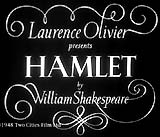


Hamlet (1948, UK), 155 minutes, D: Laurence Olivier
Director/star Laurence Olivier's sweeping, well-paced and dramatic adaptation of the classic tale was the first version of the play during the sound-talkie era. It was the Best Picture Academy Award-winner - and the first British (or non-American) film to win the top honor. It also marked the first time a director had directed himself to a Best Actor Oscar. It was memorably remade as Kenneth Branagh's Hamlet (1996). This was the second of three Shakepeare adaptations made by Olivier -- after Henry V (1944), and before Richard III (1955). The expressionistic, shadowy, black and white film opened with some lines from Shakespeare's play and then Olivier's explanatory voice-over: "This is the tragedy of a man who could not make up his mind." Shakespeare's tale (although abbreviated or streamlined, with the excision of the characters of Fortinbras, Rosencrantz and Guildenstern) was about a disconsolate and mad Danish prince (Best Actor-winning Olivier) who agonized over his moral responsibilities to his murdered father, his subjects, and his loved ones. In haunted Elsinore Castle (filmed within huge sets), the irresolute and brooding Hamlet sought an elaborate revenge for the secret and suspicious murder (an accidental snakebite -- "murder most foul") of his father King Hamlet by his own treacherous uncle, the new King Claudius (Basil Sydney), who hastily married Hamlet's mother Queen Gertrude (Eileen Herlie). Hamlet also became involved with Ophelia (Jean Simmons) in a tragic and rejected love affair ("Get thee to a nunnery"). She became suicidal after Hamlet's accidental murder of her own father Polonius (Felix Aylmer). Hamlet's most famous soliloquy "To be or not to be" defined his conflicted and depressed psychological state of mind. In the brutal, death-filled ending, all of the major characters expired.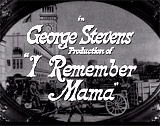

I Remember Mama (1948), 134 minutes, D: George Stevens
George Stevens' and RKO's sentimental and nostalgic post-war favorite, with DeWitt Bodeen's screenplay loosely based on Kathryn Forbes' book Mama's Bank Account - received five Oscar nominations (remarkably, four were for acting roles). The big-budget revered family classic was also based on the original 1944 Broadway play written by John Van Druten and produced by Rodgers and Hammerstein. The film's success led to a popular Lux Radio Theatre show in 1948, the best-loved early CBS-TV sitcom titled Mama (from 1949-1957) with Peggy Wood as Mama, an "ITV Play of the Week" in 1961, and a Broadway musical stage show in 1979. The story, a series of vignettes, was about a middle-class Norwegian immigrant family living on Larkin Street in San Francisco at the turn of the century (around 1910). The family was held together by a stern, resourceful, untiring, protective and loving matriarch, Marta "Mama" Hanson (Irene Dunne at age 50), and her blustering, hard-working carpenter husband Lars "Papa" Hanson (Philip Dorn). They had four growing children (only one boy): the eldest boy Nels (Steve Brown), aspiring writer Katrin (or Katherine) (Barbara Bel Geddes), Christine (Peggy McIntyre) and Dagmar (June Hedin). Family life was recalled in flashback style from the diary of the oldest daughter Katrin [Note: the "I" in the film's title referred to Katrin], as she narrated and read from her recently-written autobiographical novel. Katrin had just finished it, typing the words THE END. She stretched back and then took the many pages in her hands, and began reading from its start. The famous quote (voice-over): "But first and foremost, I remember Mama" (the conclusion of the book's introduction) was heard. As Katrin lovingly remembered, Mama struggled daily with the finances to seek a new and better life for the family members, living in an unfamiliar land. One early incident included preparing the weekly financial budget (with Mama's familiar relief: "Is good - we do not have to go to the bank"). When Nels expressed an interest to go to high school, the other family members sacrificed or volunteered to help. The family was surrounded by a colorful procession of relatives (e.g., Mama's bullying, overbearing and boisterous older brother Uncle Chris Halverson (Oskar Homolka) - a ranch owner in Ukiah who was partnered with his long-time quiet common-law wife Jessie Brown (Barbara O'Neil), and Mama's sister - timid spinster fiancee Trina (Ellen Corby) who had plans to marry homely undertaker Peter Thorkelson (Edgar Bergen)), boarders (especially impoverished Mr. Jonathan Hyde (Cedric Hardwicke)) and other friends. Memorable episodes included Dagmar's surgical operation (for removal of a mastoid), Mama's clever stealth to enter the hospital's off-limits ward to visit her, the sickness of the household's cat Uncle Elizabeth, the death of Uncle Chris, and Mama's encouragement of Katrin to aspire to be a writer. The ending revealed that Mama had deceptively fibbed to the family about having a bank account.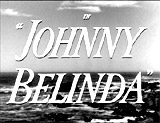

Johnny Belinda (1948), 102 minutes, D: Jean Negulesco
Director Jean Negulesco's emotionally-charged psychological and social melodrama featured sensitive acting and a Max Steiner score. It was based on the 1940 stage hit play by Elmer Blaney Harris (which was based on a real-life incident), and was remarkable as the first Hollywood film to address the problem of rape (previously the controversial subject was banned). It received twelve Academy Award nominations and only one win. It was remade as a TV movie in 1967 and 1982 with Mia Farrow and Rosanna Arquette respectively. Hearing-impaired/mute Belinda MacDonald (Best Actress-winning Jane Wyman) lived on a farm with her bullish father Black (Charles Bickford) and Aunt Aggie (Agnes Moorehead) in a small Nova Scotia fishing town on Cape Breton Island in the post-war period. Belinda, known as "The Dummy," was befriended by kindly, compassionate and patient local country doctor Dr. Robert Richardson (Lew Ayres) who taught her to read lips and sign language. In one scene, she sensed something of what music must be and tried to dance when her hand was placed upon a vibrating violin. One night, she experienced the shadowy rape-attack of drunk villager Locky McCormick (Stephen McNally) - the scene quickly faded to black, and soon after, she found herself pregnant. Everyone thought that the doctor was the father and he was disgraced. Belinda's father, who learned of the rapist's identity, was murdered at cliff's edge by him. Belinda silently recited the Lord's Prayer in sign language at the bedside of her dead father. When the rapist tried to claim the baby from her in a violent scene, she shot-gunned him to death. Subsequently, she was put on trial and defended by an attorney (Alan Napier), when Locky's jealous wife Stella (Jan Sterling), who wanted the baby, made an accusatory outburst against her dead husband: "It was him, Locky. He's the baby's father. It was his fault!" Belinda was acquitted because it was ruled that she was protecting her baby.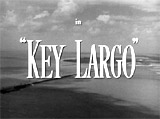



Key Largo (1948), 101 minutes, D: John Huston
Director John Huston's entertaining gangster crime-melodrama was adapted from Maxwell Anderson's stage play by both director Huston and Richard Brooks. The plot resembled Bogart's earlier film The Petrified Forest (1936) about a hostage situation. It was an intelligent, exciting, theatrical, but moody, downbeat crime drama/thriller (and melodramatic film noir). Bogart and Bacall would never star together again on the big screen (this was their fourth and final film), after having previously worked together in the classic films: To Have and Have Not (1942) (which Key Largo resembled in its dark tone), The Big Sleep (1946) and Dark Passage (1947). It told about a bullying, fugitive gangster Johnny Rocco (Edgar G. Robinson in a trademark role), who was first seen sweating profusely in a bathtub with a rotating fan, a cigar and an iced drink. He was on-the-run with fellow gang mobsters and his alcoholic lush moll and ex-nightclub singer, Gaye Dawn (Oscar-winning Claire Trevor). In the film's most memorable scene, moll Gaye desperately sang "Moanin' Low" to hopefully earn a drink from Rocco. In a Florida Keys hotel in the off-season during a violent, tropical hurricane, the snarling Rocco waited for a counterfeit money deal as he prepared to flee back to Cuba. Meanwhile, he held the various hotel residents hostage, including Frank McCloud (Humphrey Bogart), a disillusioned, returning war-scarred veteran who was visiting the newly-widowed Nora Temple (Lauren Bacall) and her wheelchair-bound father-in-law, hotel manager James Temple (Lionel Barrymore). Nora's late husband George (and James' son) had died under McCloud's WWII command in Italy. During a final confrontation on a small fishing boat returning to Cuba, when a wounded Frank had finally had enough of the escaping gang, he overtook them - and killed Rocco with three shots before alerting the authorities.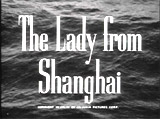



The Lady From Shanghai (1948), 87 minutes, D: Orson Welles
Welles' imaginative, complicated, unsettling film noir who-dun-it thriller was a B/W tale of betrayal, lust, greed and murder. It featured fascinating visuals and tilting compositions, luminous and brilliant camerawork (by Charles Lawton, Jr.), and numerous sub-plots and confounding plot twists. Orson Welles served as director, producer, screenplay writer, and actor, and based his screenplay upon Sherwood King's 1938 novel If I Die Before I Wake. The moody film, originally titled Take This Woman and then Black Irish, was made when major stars Orson Welles and sexy Rita Hayworth (with dyed and bobbed bleached-blonde hair) - in her last film under contract to Columbia Pictures) - were still married although estranged and drifting apart. [Note: The numerous close-ups of Rita Hayworth in the film were later added by Welles in Hollywood upon orders of the studio, to lend strength to her 'star' power.] Ultimately, the film's length was severely cut down by one hour, creating an almost incomprehensible, discontinuous, cryptic patchwork from numerous retakes and substantial edits. Although it was filmed in late 1946 and finished in early 1947, it wasn't released until late in 1948. The film was mostly ignored - it failed both at the box-office and as a critical success. In the plot, poor Irish seaman Michael O'Hara (Orson Welles) rescued Mrs. Elsa 'Rosalie' Bannister (Rita Hayworth) and soon became mesmerized by her. She was the enigmatic wife of a crippled San Francisco trial lawyer named Arthur Bannister (Everett Sloane). O'Hara joined her yachting cruise as a working crew member from New York to San Francisco (via the Panama Canal). He soon found himself embroiled in a love affair and a mysterious plot (to kill Bannister's creepy business partner George Grisby (Glenn Anders)) - the plot eventually turned deadly and implicated him in murder. The film, told through O'Hara's narration, was shot on locations including Acapulco, San Francisco, and at Columbia Studios sets, and featured numerous classic set-pieces including: the aquarium scene, and the funhouse and Hall of Mirrors shoot-out climax (shot in San Francisco's Playland).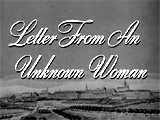

Letter from an Unknown Woman (1948), 87 minutes, D: Max Ophuls
German director Max Ophuls' most successful Hollywood film (adapted from Stefan Zweig's 1922 novella) was this quintessential "women's film." The emotionally-complex, bittersweet, old-fashioned tearjerker romance was conveyed via a series of flashbacks. Both protagonists faced an inextricable impasse and experienced numerous missed opportunities over a span of twenty years - and ultimately failed to attain true romance. The lush and haunting film told about Lisa Berndl (Joan Fontaine), a beautiful young woman with a childhood crush and doomed love for a charmingly suave, philandering concert pianist Stefan Brand (Louis Jourdan) in 19th century Vienna. The night before the cavalier, callow and self-absorbed pianist was due to fight a dawn duel for offending a lady's honor with Lisa's wealthy husband Johann Stauffer (Marcel Journet), he received a letter from a strange, unknown woman - the key to his continual self-destruction and downfall. He was, in fact, planning to avoid the duel and have his mute valet-servant John (Art Smith) pack his bags. Through the deathbed letter, he learned for the first time about the young teenaged girl, his next-door neighbor in his apartment building, and her undying love that she felt for him through the years during other encounters. Their acquaintance included a pregnancy and son Stefan Jr. (Leo B. Pessin) - although he continually failed to recognize her at each new meeting. During the nighttime reading of the letter, Stefan looked at photos of his son and learned that Lisa was married, but then the son that he fathered with her had died of typhus - and 27 year old Lisa had also died of the same disease ("By the time you read this letter, I may be dead"). Resolute after remembering her, finally, Stefan decided to confront Lisa's husband in a fateful duel.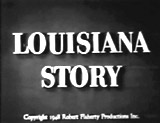

Louisiana Story (1948), 78 minutes, D: Robert J. Flaherty
This was documentarian Robert Flaherty's last film, produced (and financed) by Standard Oil Company with a budget of approximately $250K. It had a Pulitzer Prize-winning original score by composer Virgil Thomson. The documentary (with faux authenticity) depicted the growing, devastating effects of the oil industry on the Louisiana bayou country, although naive director Flaherty's underdeveloped, poorly-acted film contained no explicit commentary on the ecological effects or the significant cultural transition about to take place. A young Cajun boy named Alexander Napolean Ulysses Latour (Joseph Boudreaux), who lived in the marshlands of Petit Anse Bayou, watched as off-shore platforms were built and oil riggers-drillers worked, after his trapper father (Lionel Le Blanc) signed a lease agreement with an oil company. His simple, nature-loving, idyllic, and peaceful way of life (hunting, fishing, tussling with alligators) with a pet raccoon as he explored and canoed through the bayous, would soon change forever. The fascinated, adventurous, and daydreaming Cajun boy regularly visited with the friendly Driller (Frank Hardy) and the Boilerman (C. P. Guedry). One day with their monstrous, towering steam-driven oil derrick, the drillers struck oil with a money-making geyser that was soon capped with a Christmas tree - readied for future pumping.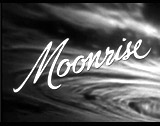



Moonrise (1948), 90 minutes, D: Frank Borzage
Director Frank Borzage's and Republic Pictures' film-noirish crime melodrama, the director's last great film, was based on Theodore Strauss' 1946 best-selling novel (that was first serialized in two issues of Cosmopolitan Magazine in mid-1946). Its themes of tortured psychic depression, gloomy melancholy, and murder set the tone for the very complex psychological drama. The film's brilliant opening montage of wordless visual story-telling was set in the small Virginia town of Woodville. At the public hanging of an accused Virginia killer, Jeb Hawkins, the convicted murderer (for shooting and killing an incompetent doctor who had indirectly caused his wife to die by not making a house call but offering only a bottle of pills - the wrong tablets) was expressionistically marched to the gallows in a rainy downpour. The image was paired with the view of a crying baby - the man's child had a shadow of a dangling play-doll dangling by a string above its crib, casting a transposed duplicate of the hanging man onto its blanket, to convey the belief that "bad blood" was being transmitted from one generation to the next. The montage continued with the sad and mistreated childhood of outcast Danny Hawkins (Johnny Calkins as 13 year old), who often fought on the school playground against his teasing, taunting and tormenting schoolmate Jerry Sykes (Michael Dill as 13 year old), who chanted with others their prejudiced view of Danny because of his father: "Danny Hawkins' dad was hanged!" The next sequence was an altercation outside a dance hall, where adult Danny Hawkins (Dane Clark as adult) argued with rich banker's son Jerry Sykes (Lloyd Bridges as adult), his lifelong tormentor, over their mutual love of warm-hearted, local schoolteacher Gilly Johnson (Gail Russell). Unbeknownst to Danny, Gilly was the fiancee of the teasing, arrogant, and bullying Sykes. The next shot was a pair of legs (Danny's) walking near a swamp (called Brother's Pond) to meet with Jerry Sykes, to engage in a bloody and vicious fist-fight. In a drunken rage, Hawkins grabbed a rock that Sykes had picked up and repeatedly smashed his skull with it - murdering him in self-defense. He would soon suffer the same fate as his father - pursued for a crime. He left an important clue behind - his pocket-knife dangling in a tree. An investigation followed with a frenzied manhunt for the killer. After the murder, Danny danced with Gilly (she asked: "What's come over you?...I'm a schoolteacher, I can't afford to fight with you in front of other people"), and then during a night drive with her from the dance, Danny experienced a near-fatal car crash when he had a vision of Sykes fighting with him. After developing a strange friendship between each other, within a ruined Southern mansion (Blackwater Mansion), Hawkins surreptitiously met Gilly, and in the midst of their burgeoning love affair, Gilly imagined that they were attending a romanticized Civil War era ball in the house when she adopted an exaggerated Southern accent as the plantation's owner Mrs. Blackwater - they waltzed together and spoke of their mutual love before they kissed - and the film faded to black. Danny feared being discovered for the crime, and nearly-strangled harmless, mentally-handicapped mute Billy Scripture (Harry Morgan) who found Danny's knife. Once Sykes' body was found after only a few days, Danny was even more fearful of being caught. In a pivotal scene at a county fair, panicking Danny (with Gilly) - fearing being caught while sharing a ferris-wheel ride with the town's Sheriff Clem Otis (Allyn Joslyn), caused him to jump, and increased further suspicions. During pursuit by the Sheriff (and his dogs), Danny ventured into the swamp to the backwoods home of his wise Grandma (Ethel Barrymore); she helped him to reflect on his past when she told him that his father's act of murder was uncharacteristic of him. Danny realized that he should control his fate and turn himself in for manslaughter - to free himself from guilt and his past and his feelings about having "bad blood." He stood at his father's grave, reflected about his past, and spoke to him: "I ain't proud of what ya done, Pa. All the same, I didn't mean what I said last night. You did the best you could to even things up. That's what I'm doin' now. Maybe we'll both have some peace." In the final scene, he approached the Sheriff to peacefully surrender. He reunited with Gilly and hugged her as she assured him: "It’s wonderful to see your face, Daniel. To really see it." The optimistic scene was flooded with bright light as Danny freed himself of his guilt and self-hatred. The Sheriff refused to have Danny handcuffed: "Let him walk back like a man" as they returned to town.
(opening - no title)
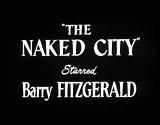



The Naked City (1948), 96 minutes, D: Jules Dassin
Director Jules Dassin's hard-boiled urban docu-drama crime/noir film about a police murder investigation was a great semi-documentary film from Universal. It was the first studio feature shot on location in New York City. It featured raw energy and Oscar-winning cinematography by William Daniels. It was the film that inspired the 50's ABC-TV series - with its famed ending quote delivered as an epitaph for the murdered woman: "There Are EIGHT MILLION Stories In The Naked City - This Has Been ONE Of Them." The grim, fact-based story opened with aerial views of New York City (no title screen!) - accompanied by credits narration from the film's producer, tabloid journalist Mark Hellinger (who conducted six months of interviews with the NYPD to gather accurate details and characterizations) - Hellinger was also the voice of the final quote. Then, it gave an account of the brutal robbery-murder of attractive, and promiscuous 26 year-old blonde fashion model Jean Dexter in her NYC apartment's bathtub (was it a suicide?), and the subsequent manhunt for the killer by homicide detectives, involving veteran cop Det. Lt. Dan Muldoon (Barry Fitzgerald) and younger partner Det. Jimmy Halloran (Don Taylor). In an emotional sequence at the City Morgue, Jean's estranged parents - the Batorys (Adelaide Klein and Grover Burgess), identified her body. One of the prime suspects was Jean's fast-living boyfriend, deceitful Frank Niles (Howard Duff), although he had an alibi. In the film's memorable, thrilling, and heart-pounding climax, ex-con murder suspect Willie Garzah (aka Willie the Harmonica) (Ted de Corsia) ran through the Lower East Side tenements until being cornered on the Williamsburg Bridge, where he climbed to the top of the bridge tower. He refused to surrender, was shot a few times, and fell to his death.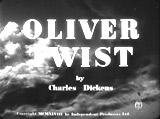



Oliver Twist (1948, UK), 116 minutes, D: David Lean
David Lean directed this dark, expressionistic and shadowy British production (with beautiful cinematography by Guy Green) after the success of his earlier Dickens' hit Great Expectations (1946). This was an excellent and straight-forward screen portrayal of the classic 1839 Charles Dickens story of the title character among the downtrodden and abused classes of 19th-century England. It was a remake of the first film version of the tale by Poverty Row's Monogram studios in 1933, with Dickie Moore in the lead role. It was also remade as a colorful Best Picture-winning musical, Oliver! (1968) by Columbia Pictures - an adaptation of the Broadway hit. This film's opening was delayed in the US until 1951 due to protesting Jewish groups that claimed it was anti-Semitic, and some scenes were initially censored. In the powerful first scene, the title character's exhausted Mother (Josephine Stuart), in labor, staggered over the moors and gave birth, before dying, at a work house. Orphan boy Oliver Twist (John Howard Davies) lived at the parish work house where he was systematically abused by the callous officials led by Mr. Bumble (Francis L. Sullivan). When 9 year-old Oliver brazenly asked for more porridge-gruel ("Please sir, I want some more"), his punishment by the harsh authorities was severe, and he soon after escaped from the institution and ran away to London. A company of thieves, including pickpocket the Artful Dodger (Anthony Newley), the hideous, unsavory, hook-nosed rogue Fagin (Alec Guinness), "the Jew," and the murderously evil Bill Sykes (Robert Newton) with his prostitute girlfriend Nancy (Kay Walsh), recruited the innocent into a life of petty street crime. After the demise or arrest of most of the gang, Oliver was rescued and taken in by kindly gentleman and benefactor Mr. Brownlow (Henry Stephenson), who was revealed to be Oliver's actual grandfather.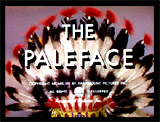

The Paleface (1948), 91 minutes, D: Norman Z. McLeod
Director Norman McLeod's early Technicolored spoof of western films (it was the highest grossing Western spoof until Blazing Saddles (1974)) - was one of Bob Hope's biggest box-office hits, with lots of one-liners, slapstick, and wisecracks. It was noted for having Bob Hope's musical rendering of "Buttons and Bows," the Academy Award Oscar-winner for Best Song. Scriptwriter Frank Tashlin fashioned it as a satirical version of Owen Wister's novel The Virginian. It was followed by the sequel, Son of Paleface (1952) (again with scriptwriter Tashlin now as the director, and the two main stars), and a remake The Shakiest Gun in the West (1968) with quirky comedian Don Knotts. In the plot, bumbling and inept frontier dentist Peter "Painless" Potter (Bob Hope) had learned his trade through a correspondence school. The quack dentist became acquainted with the pistol-wielding, big-breasted Calamity Jane (Jane Russell). The female outlaw had been released from prison in exchange for becoming an undercover government agent working with Governor Johnson (Charles Trowbridge) on a case involving the smuggling of guns to the Indians. On her way to Fort Deerfield to meet up with her secret agent male partner who would be posing as her fake pioneering husband and lawyer Jim Hunter, she learned that he had been killed. The cowardly and nerdy dentist Potter was recruited to take his place and marry sharp-shooting Calamity Jane to continue her innocent cover. Her goal was to dupe the outlaws into thinking that Potter was a federal agent so that she could catch the outlaws and receive a pardon for a 10-year prison sentence. [Note: The gun-running renegades were later revealed to be Toby Preston (Bobby Watson), the owner of The Dirty Shame saloon Terris (Robert Armstrong), and Gov. Johnson's own traitorous-turncoat Indian Affairs chief Jasper Martin (Jack Searl).] (A running joke was Hope's many failed attempts to kiss co-star Jane Russell - he was repeatedly knocked out on the back of his head.) By film's end, Jane gave all the heroic credit to Potter for saving their wagon train from a war party of Indians who attacked their pioneer camp. Jane also saved Potter during a gun duel shootout and killed his opponent, jealous boyfriend Big Joe (Jeff York). However, Potter also earned merit by rescuing the two of them from being burned at the stake by scalp-hungry Indians, while disguised as a medicine man. In the final scene, they exposed their true feelings for each other en route to a honeymoon. But then Jane was pulled from the wagon by one of the horses and dragged off into the distance, and Potter turned to the camera and quipped: "What do you want, a happy ending?"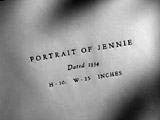


Portrait of Jennie (1948), 86 minutes, D: William Dieterle
Director William Dieterle's visually-rich, romantic fantasy was based upon Robert Nathan's 1940 novella. It was nominated for two Academy Awards (including Best Cinematography) and won for Best Special Effects. The plot was basically a soft-focus daydream. Beginning in the Depression-Era year of 1934, alienated, struggling and depressed artist Eben Adams (Joseph Cotten) (with sketches tucked under his arm) was in NYC's Central Park one morning where he first encountered enigmatic young schoolgirl Jennie Appleton (Jennifer Jones). She was strangely dressed in old-fashioned, turn-of-the-century clothes. It would be the first of many ambiguous encounters (with a different Jennie each time at different stages of her life as she grew older), emphasized by Jennie's song that she sang to herself: "Where I come from nobody knows, And where I'm going, Everything goes. The wind blows, the sea flows. Where I come from, Nobody knows." [Note: The title song became a hit record for Nat King Cole.] His relationship with Jennie grew over time and began to change him and affect his way of life. He became more passionate and inspired in his paintings, as Jennie became his muse. He gradually learned that the traumatic events that Jennie was experiencing had occurred years earlier - and that he was communing with her "ghost" across time. He sought verification of the realities about Jennie's life, first at the location of an old music hall (where her parents had performed vaudeville in the past in 1910 at Hammerstein's Victoria). He learned that Jennie's parents had been killed one night when their high-wire broke during a performance. He continued to find clues to Jennie's later life at her convent school, where she was sent following her parents' deaths. (He ultimately learned from the Mother Superior, Mary of Mercy (Lillian Gish) that Jennie drowned in the 1920s after her sailboat was lost in a tidal wave off Cape Cod.) As he fell in love with Jennie, he was inspired to paint an official portrait of her (that would require more than one sitting) and showed the artwork to art dealers Miss Spinney (Ethel Barrymore) and Matthews (Cecil Kellaway) who were deeply impressed by his skill. When the portrait was finished, Jennie left him forever. In the film's finale, he followed her one last time to "Land's End" - the lighthouse on a rocky point on Cape Cod, where she had died. On the anniversary of her death date, October 5, he rented a boat and sailed out to the lighthouse during a storm - and there he was able to momentarily reunite his spirit with hers (Jennie vowed she would love him forever) before she was swept away by the tide in her small boat - it would be her final disappearance. Once the hurricane subsided, he was only left with symbols of her reality - her silk scarf and his portrait of her. The closing shot was of her portrait - now in striking 3-strip Technicolor. The film asked the ultimate riddle - was Jennie really alive, or only imagined in Eben's memory? Their spiritual love would presumably endure eternally beyond death and they would always be together through the coming years through his art.

Red River (1948), 133 minutes, D: Howard Hawks
Action director Howard Hawks' classic, tightly-structured 40s epic Western was one of the best American westerns ever made, with beautiful photography by Russell Harlan. This was one of producer/director Howard Hawks' most extravagant and ambitious films (and his first western), and it cost over $3 million (overbudget) at the time - an exorbitant sum, but became a top-grossing film of the year. It was a familiar tale of father/son rivalry and a battle of wills between the two opposites in a rebellion spanning a time period of fifteen years. In the film's opening set in 1851, Tom Dunson (John Wayne in one of his best performances and his first film of five for Hawks) decided to leave a wagon train from St. Louis on its way to California, in order to set out on his own as a Texas rancher and cattle baron. He split up his loving sweetheart Fen (Coleen Gray) with plans to join together with her later. Shortly afterwards, Dunson was dismayed to learn that members of her wagon train had been massacred by Comanche Indians. With Dunson's side-kick Nadine Groot (Walter Brennan), the two came across a young orphaned boy (the wagon train's sole survivor) named Matt (Mickey Kuhn as young boy) wandering on the prairie with a lone cow, and it was decided that Tom would raise him as his foster son - and "And that was the meeting of a boy with a cow and a man with a bull and the beginning of a great herd." The threesome soon claimed land north of the Rio Grande for a ranch known as "Red River." A montage then shifted to almost fifteen years later to 1865, at which time Dunson's herd needed to be transported north to the market in Missouri. The western film chronicled the first monumental, historic cattle drive north along the Chisholm Trail to their rail-head destination in Abilene, Kansas, and authentically depicted an epic, bleak and tough journey, similar to the ones in The Odyssey or in Exodus (in the Old Testament), that was fraught with external dangers, threats, tests of strength, and internal contentious tensions. By this time, Tom's less harsh, surrogate, grown-up adopted son Matthew Garth (Montgomery Clift in his first film) had become a major strong-willed antagonist. He faced off against his hard-nosed, self-made, bitter, dictatorial, ruthless and tough commanding father. During the near-suicidal cattle drive, their vicious confrontations, capped by Dunson's tyrannical, unbearably harsh treatment of deserters, eventually led to a mutinous revolt - a western Mutiny on the Bounty - when the cowpokes supported the natural leader - Matt. Matt rescued a wagon train (of dance hall girls and gamblers) from an Apache Indian attack - and made the acquaintance of Tess Millay (Joanne Dru), one of the pioneer women - and established a romantic relationship with her. Dunson vowed to pursue and kill his son in a murderous quest that climaxed in an inevitable, brutal fist-fight and show-down. Their final savage confrontation occurred at sun-up, when Dunson saw Matt in the distance in Abilene. Dunson dismounted and strode through the stray cows (actually plowed or waded through them like water in a river), and drew his gun on Matt - and challenged Matt. When Matt refused to draw, they got into a lengthy, fist-fight brawl. The two men were reconciled when their argument was broken up by the tough woman in the film, Matt's girlfriend Tess, who stepped in and ended their final fight to the death with a gun. They obeyed her by ultimately reconciling after Tom told Matt that he should marry Tess ("You'd better marry that girl, Matt"). In the film's epilogue, in the last lines of the film, Dunson ordered one last thing, promising to add Matt's initial to the Red River D cattle brand (as a new branding iron) to make him a full partner in his cattle business.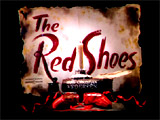




The Red Shoes (1948, UK), 133 minutes, D: Michael Powell, Emeric Pressburger
This beautiful and sensitive film came from the masterful directing/producing team of Powell and Pressburger. The dramatic masterpiece, filmed in breathtaking, gorgeous Technicolor, has often been considered the best ballet film ever made. The exquisite musical tragedy provided a realistic and close look at the backstage world of a ballerina as it pursued the theme of the choice between love/marriage and/or her artistic career. The tale was taken - metaphorically - from Hans Christian Andersen's tragic fairy tale of the same name, about a ballerina who wore an enchanted pair of magic, red ballerina slippers that couldn't be removed and forced her to never stop dancing - and she danced herself to death. The film was basically a love triangle-drama involving the three main characters (a female and two males). An ambitious and dedicated young, red-headed English prima ballerina Victoria "Vicky" Page (Moira Shearer) was made a star by her Svengali-like mentor impresario and producer-conductor Boris Lermontov (Anton Walbrook) of the Lermontov Ballet Company. But she was soon torn between her struggling conductor-composer husband Julian Craster (Marius Goring) who could offer her nothing but his love, and the obsessed impresario who could further her dancing career with the ballet company. She painfully struggled with making a difficult choice between her career (the art of ballet) and love. Her desire to dance conflicted with her need for love - and ultimately led to her death. The film's magical highlight was a 15-minute stylized, imaginatively-filmed "Red Shoes" ballet blended and integrated seamlessly within the storyline about the characters. The film ended with Vicky's melodramatic tragic death scene when she was propelled to her death just before an encore concert presentation of The Red Shoes ballet. She had been persuaded by Lermontov to return to dance the ballet once again. Just before the performance, Julian arrived to demand that Vicky leave with him at once, although she was also commanded to remain by Lermontov. Vicky contended that her true desire was to dance and she chose to stay and dance and not leave with Julian. But then when she became hysterical, conflicted, and confused about what to do, the controlling red shoes willfilly took her down the steps of the Opera House to a balcony overlook and forcefully pulled her off (into the path of an oncoming train on the tracks below). She tragically died (was it an accident or suicide?), as did the girl in the ballet - paralleling real life with the ballet's plot. The scheduled ballet was performed as planned but without her (with a spotlight shining on the floor where she would have been dancing) after an announcement by Lermontov: "Ladies and Gentlemen. I am sorry to tell you that Miss Page is unable to dance tonight, nor indeed... any other night. Nevertheless, we've decided to present The Red Shoes. It is the ballet that made her name, whose name she made. We present it because we think she would have wished it." The film's final images were back at the location of Vicky's accident, with a closeup of her bloody legs (and tights) and feet wearing the shoes. When she requested that Julian remove her red ballet shoes, she expired.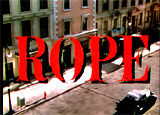


Rope (1948), 80 minutes, D: Alfred Hitchcock
Director Alfred Hitchcock's first Technicolored feature film was this experimental thriller, the first of four films with James Stewart, and the famed director's most controversial work. The stagebound film, based upon Patrick Hamilton's 1929 play Rope's End, was notable for its major experimental "stunt" - the seamless intercutting of 10 long takes (ranging from 4 and a half minutes to 10 minutes), creating the appearance of the film's action occurring all in 'real-time' in a single, continuous shot (of 80 minutes, although the film's actual time frame was 100 minutes) - however, there were clever splices between takes (and two brief, reverse-angle shots too). The story was loosely based on the notorious 1924 Leopold and Loeb murder case involving two University of Chicago students who murdered a 14 year old for the thrill of it. The film also featured two gay villains, both wealthy pseudo-intellectuals and bachelors. The two implicitly homosexual and psychopathic college buddies-lovers were -- nervous and fearful Phillip Morgan (Farley Granger), and the more caustic and arrogant Brandon Shaw (John Dall). In the opening scene, the two thrill-killed (by rope strangulation) a third individual, Harvard undergraduate and friend David Kentley (Dick Hogan), and then hid his body in an antique wooden chest (used as the dining table) while hosting a dinner party for David's friends and relatives. The guests invited to the occasion were the victim's father Mr. Henry Kentley (Sir Cedric Hardwicke) and his aunt Mrs. Anita Atwater (Constance Collier), David's fiancee Janet Walker (Joan Chandler), Janet's ex-boyfriend Kenneth Lawrence (Douglas Dick), and the killers' ex-prep-school housemaster/teacher Rupert Cadell (James Stewart), whose philosophical Nietzsche lectures about "superman" (the acceptability of the privileged and superior few to murder inferiors) inspired the impressionable pair. In one chilling, sexually-tinged scene, Shaw recounted his feelings about the murder to Morgan: "I don't remember feeling very much of anything -- until his body went limp and then I knew it was over...I felt tremendously exhilarated!" Shaw also dared the guests, particularly Cadell, to uncover why David was conspicuously absent and hinted about their secret that a body was concealed in the trunk in the middle of the room. The thriller ended when guilt-ridden Cadell suspiciously realized that his former students had actually carried out his mad theories. With gunshots, he signaled for the police to apprehend the killers.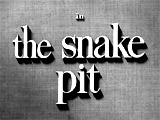


The Snake Pit (1948), 108 minutes, D: Anatole Litvak
Director Anatole Litvak's and 20th Century Fox's still-disturbing psychological drama told about the horrors of mental institutions (with shadowy images of inmate torture). The daring film was based on the fictionalized account of hospitalization in squalid conditions by Mary Jane Ward's 1946 semi-autobiographical best-selling novel. The non-escapist, controversial drama was a representative social-problem film (similar to The Lost Weekend (1945) dealing with alcoholism, the homefront adjustment of returning veterans in The Best Years of Our Lives (1946), or the problem of anti-Semitism in Gentlemen's Agreement (1947), and the issue of racial prejudice in the upcoming Pinky (1949)). It was also one of Hollywood's first mainstream films to sympathetically deal with the issue of the mentally-ill. Other similar films included Frederick Wiseman's documentary Titicut Follies (1967), or Best Picture-winning One Flew Over the Cuckoo's Nest (1975). In the story's opening, young inmate Virginia Stuart Cunningham (Oscar-nominated Olivia de Havilland) was sitting on a park bench - completely confused, puzzled, and hearing voices. It was revealed that she had been institutionalized (after a psychotic breakdown following severe depression) in the over-crowded Juniper Hill State Hospital. With insomnia, memory loss (amnesia), and mood swings, a confused, withdrawn and frightened Virginia could not remember the circumstances of her incarceration ("I can't be sure of anything anymore"). Chief psychiatrist Dr. Mark Kik (Leo Genn), her main compassionate treatment-therapist, used psychotherapy techniques (narcosynthesis, hydrotherapy, shock therapy and hypnosis) to discover the repressed reasons for her mental illness, pain, distress and erratic behavior - seen in various flashbacks of her troubled, distraught and bittersweet childhood. With a cold, domineering and unloving mother Mrs. Stuart (Natalie Schafer), and a caring but strict father Mr. Stuart (Damian O'Flynn), Virginia desperately craved love, and became emotionally over-attached to her father. She was wracked with guilt when her father died of uremia. Later when she was older and dating a fatherless eldest son named Gordon (Leif Erickson), she became physically sick when he asked for her hand in marriage. While riding with him as a passenger, he was tragically killed in a car accident and his death added to her feelings of self-blame. The urgent efforts of Virginia's newlywed husband Robert Cunningham (Mark Stevens) to cure her and get Virginia released failed when she panicked before a hospital staff-panel of clinical interrogators. During the session, she became uncontrollably paranoid, full of rage, and traumatized (she even bit her doctor), and had to be placed in Ward 12 for seriously-ill patients. Instances of progress were often followed by setbacks, regression and relapses. After a transfer back to Ward 1 where recovering patients were about to be released, she experienced a troubling incident with tyrannical and abusive nurse Davis (Nancy Craig) and was goaded into an emotional outburst. Subsequently, she was punished by being placed into a strait-jacket. One of the film's most famous images toward the end of the film provided its title of "snake pit" - it was the famous top-shot and pull-back view of the protagonist, surrounded by insane and babbling patients. She explained the over-crowded conditions to Dr. Kik: "It was strange - here I was among all those people, and at the same time, I felt as if I were looking at them from someplace far away. The whole place seemed to me like a deep hole, and the people down in it like strange animals, like, like snakes, and I'd been thrown into it, yes, as though, as though I were in a snake pit....And I was shocked into thinking that maybe I wasn't as sick as the others and I really might get well." With further personal and proper care from her sensiitive doctor, she was returned to Ward 1 and was able to again appear before the hospital staff as a confident, cured and recovered patient. She had reached self-understanding and sanity - and was released.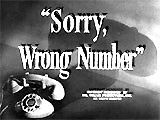



Sorry, Wrong Number (1948), 89 minutes, D: Anatole Litvak
This engrossing, expressionistically-filmed, dark psychological thriller and film noir was adapted from a famous and popular 1943 CBS radio play (one-half hour) with Agnes Moorehead by the play's author Lucille Fletcher. It was later remade as a 1989 TV movie starring Loni Anderson. The suspenseful film told about bedridden, spoiled, manipulative hypochondriac heiress Leona Stevenson (Oscar-nominated Barbara Stanwyck), whose domineering father was wealthy drug company industrialist James "J.B." Cotterell (Ed Begley). She lived alone in a Manhattan apartment where she was basically helpless and confined to her bed or wheelchair if her nurse was not in attendance. One day, she accidentally overheard a crossed-wires telephone conversation between two thugs. The strangers were discussing the lurid details of a planned murder plot for that evening at 11:15 (the exact time of a loud, passing train). (Did she hear plans for her own murder?) Then, the invalid, psychosomatic woman received two other strange phone calls on her phone (PLaza 5-1098), and slowly suspected that she might be the object of the homicide. When she reported her fears to the operator and to authorities, they didn't believe her. She made phone calls to try and locate her missing, weak-minded, henpecked and greedy husband Henry J. Stevenson (Burt Lancaster), who was originally portrayed as obedient and loving. Through a series of well-constructed flashbacks, she recalled her first encounter with her husband, how she stole him away, and remembered parts of her life with him and others. More calls were made to her husband's secretary Elizabeth Jennings (Dorothy Neumann), to her former married acquaintance Sally Hunt Lord (Ann Richards) (Henry's blonde ex-girlfriend), and to her own doctor Dr. Phillip Alexander (Wendell Corey). She was told that her recent diagnosis that she was psychosomatic (meaning she could be cured) had been kept secret from her by Henry. Leona also spoke to chemist Waldo Evans (Harold Vermilyea) at her father's pharmaceutical company, the Cotterell drug company, where Henry worked as a decorative VP. She became aware that the frustrated Henry had a number of dirty secrets including his role as an amateur corporate thief - he was suspiciously meeting with Sally for lunch, while he was being swindled and blackmailed over a plan to steal drugs from the company and sell them to a professional gangster fence named Morano (William Conrad). Reportedly, Henry was bypassing Morano to fence the drugs himself, for higher profits. There had been an exchange of money at a deserted Staten Island house (belonging to Waldo). Coincidentally, Sally was married to city district attorney Fred Lord (Leif Erickson) who was investigating Henry and building a case against him. Was it possible that Henry was attempting to inherit his wife's estate (and an insurance payout) to pay off a lost-profits debt of $200,000 to the blackmailing Morano, by hiring a hitman to kill Leona? Powerless and with time dwindling in the thrilling finale, the victimized Leona became increasingly desperate and frantically tried to call Henry for help before it was too late. When he finally called her, she tearfully apologized and promised any money that he needed. During their conversation in the film's twist ending, Henry began to realize that the police had already captured Morano and his thugs, and that they had discovered the burned down Staten Island house. He no longer had to raise money and Leona's murder was now completely unnecessary. Henry instructed Leona to go to her balcony and scream for help, but it was too late. He listened helplessly as an intruder entered her room and strangled her to death. In the final line of dialogue when Henry called back, he heard the film's title spoken by an unknown man: "Sorry, wrong number."


Spring in a Small Town (1948, China) (aka Xiao cheng zhi chun), 98 minutes, D: Mu Fei
This melancholy, haunting romantic melodrama was about a love triangle, similar to the themes of David Lean's Brief Encounter (1945, UK) and Kar-Wai Wong's In The Mood For Love (2000, HK/China). It was based on Li Tianji's short story, and was remade by Zhuangzhuang Tian's as Springtime in a Small Town (2002, China). It remains one of the greatest Chinese films ever made. It was shot in the post-war period when China had been devastated by Japanese occupation during the Sino-Japanese War, and had not yet been overtaken by Mao Tse Tung's Communist Party. The delicate, non-political, slowly-paced film was suppressed and banned by the Communists and not available for viewing until the 1980s. In the story, Zhou Yuwen (Wei Wei) lived a lonely, unsatisfied, unhappy and dejected life, shackled and frustrated by her care for her gentle and kind, but sickly and emasculated husband-landowner Dai Liyan (Shi Yu), once prosperous but now poor. His teenaged sister Dai Xiu (Zhang Hongmei) and faithful servant Lao Huang (Cui Chaoming) also lived in their dilapidated home, the ruins of a large estate. When her childhood sweetheart from ten years earlier, Zhang Zhichen (Li Wei), also Liyan's best friend and now a Shanghai doctor, reappeared into Yuwen's life, lustful urges began to develop along with conflicted feelings. A significant voiceover narrative described Yuwen's perspective and emotional feelings of unspoken and repressed desires. Realizing his wife's attraction to Zhang, Liyan attempted suicide by overdose but was saved by his friend.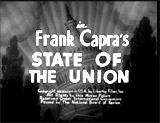

State of the Union (1948), 124 minutes, D: Frank Capra
Director Frank Capra's and MGM's politically-tinged romantic melodrama and political satire was about the 'state of the union' of an estranged couple brought together for expediency's sake. It was adapted by scriptwriters Myles Connolly and Anthony Veiller from the original Pulitzer Prize-winning 1945 Broadway play by Russel Crouse and Howard Lindsay. It was the 5th of 9 films made by the collaborative team of Tracy and Hepburn. In the plot, Grant Matthews (Spencer Tracy) and his estranged wife Mary Matthews (Katharine Hepburn) were brought together during Grant's Presidential campaign. The wealthy, self-made industrialist-tycoon, an airplane manufacturer, was coerced to run for the top position by his new mistress - over-bearing, ruthless, and seductive Republican newspaper publisher Kay Thorndyke (Angela Lansbury). The power-hungry millionaireness-villainess of Thorndyke Press (a chain of newspapers) would bankroll Grant's campaign as a 'dark horse' Republican candidate for the highest office (he would be promoted as a sincere man of the common people). He would be managed by voracious, manipulative political strategist Jim Conover (Adolphe Menjou) and newspaper columnist-journalist 'Spike' McManus (Van Johnson) who served as his press secretary. To avoid character issues in his marital background, and for appearance's sake, Grant's separated wife Mary, an idealist, was required to pose as his devoted and faithful 'wife by his side.' Unavoidably as they spent time together during the campaign, their romantic affections for each other were rekindled. Mary opposed Grant's willingness to sacrifice and deceitfully compromise his honesty and ideals for political expediency (due to Kay Thorndyke's manipulative urgings), in order to win influential backers, the primaries and delegate votes in the 1948 Republican National Convention. In the stirring conclusion, he was prepared to deliver a live, nationwide radio (and TV) speech broadcast to 20 million people as a 'fireside chat' from his Long Island home. He interrupted Mary's glowing introduction that praised him as "honest, uncompromising, fearless, a man of great vision and enormous courage." Grant realized that Mary had also been corrupted by his Washington-based power brokers-backers who were fraudulent and dishonest. The self-respecting Presidential candidate finally understood how he had turned against and "sold out" his own values (due to his wife's valuable perspective) to a "gang of corrupt politicians." He stepped forward to denounce his own behavior and any further duplicity on Mary's part. He also refused to be cut off, yelling out angrily as he seized the microphone: "Don't you shut me off. I'm paying for this broadcast!...I have as much right to run for President as a gutter-rat!" He openly admitted his tremendous wrong-doings and complicity: ("I am no lamb led to the slaughter, I ran to it...My whole campaign was a fraud!"). He urged all of the other party candidates to be honest, to denounce phoniness, and to not become "double-dealers and crooks." After his appeal, he withdrew himself from the competition, and apologized to the audience and to Mary, asking for her forgiveness. However, he then promised to reform the political landscape: "I'm gonna open doors, break down windows, let in fresh air. I'm going after every candidate who compromises, and I'm going after every lazy voter who doesn't vote." After the speech, the Matthews were reconciled and saved their marriage, press secretary 'Spike' was fired, and the icy, powers-behind-the-throne Kay Thorndyke and unscrupulous strategist Jim Conover were forced to find a new candidate.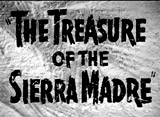


The Treasure of the Sierra Madre (1948), 119 minutes, D: John Huston
Director and screenwriter John Huston's classic adventure film, an adaptation of B. Traven's 1927 novel, was about three gold prospectors in the Mexican wilderness - it was essentially a tale of lustful greed, treachery, paranoia and suspicion. The three ill-matched men in the mid-1920s included innocent, honest and young American Curtin (Tim Holt), wise and experienced, fast-talking, grizzly, toothless old-timer Howard (Walter Huston, the director's father), and Fred C. Dobbs (Humphrey Bogart), a greedy, deranged, selfish bastard who distrusted everyone. The two down-and-out drifters Curtin and Dobbs had first met in Tampico, Mexico (where Dobbs won the lottery), before teaming up with Howard - whom they met in a cheap flophouse. Their gold booty strike and fortune in the Sierra Madre Mountains bred violence and "gold fever," the threat of Mexican bandits led by Gold Hat (Alfonso Bedoya) who posed as the Federales, an end to their gold-digging friendships, and the homicidal undoing of the avaricious Dobbs when he was killed for his boots and mule by Gold Hat's bandits. The Mexican outlaws did not realize that the 'dust' in Dobbs' saddle bags was gold. It ended with an ironic climactic scene when the wind blew the discarded gold dust away - back into the Sierra Madres.

Unfaithfully Yours (1948), 105 minutes, D: Preston Sturges
Director-producer-writer Preston Sturges' wonderfully stylish and witty fantasy-screwball comedy was the last of his Hollywood films. It was remade, unsuccessfully, with Dudley Moore in the lead role in 1984. The black comedy was unsuccessful at the time of its release, possibly due to the scandalous circumstances surrounding the suicide of star Rex Harrison's lover - troubled actress Carole Landis, when he refused to get a divorce and marry her. The splendid, fine farce, told with a non-linear narrative, was the tale of British, middle-aged reknowned symphony orchestra conductor Sir Alfred de Carter (Rex Harrison) who suspected his lovely younger wife Daphne (Linda Darnell) of infidelity. During a visit to England, his wealthy brother-in-law August Henshler (Rudy Vallee), due to a misunderstanding ("Keep an eye on my wife for me"), had taken him literally and hired private investigator Detective Sweeney (Edgar Kennedy) to "sleuth after" Sir Alfred's wife in his absence. After reading the report upon his return, the jealous Sir Alfred suspected that Daphne was having an affair with his own young private secretary, Anthony Windborn (Kurt Kreuger). Then, while leading his orchestra in three different pieces, Sir Alfred elaborately daydreamed three very different versions or scenarios of how he would solve the problem of his wife's alleged infidelity - each one accompanied by a classical music piece that matched the mood. During the conducting of Rossini's overture to the opera Semiramide, Sir Alfred imagined himself, in a complex and ingenious revenge fantasy, murdering femme fatale Daphne by razor-slashing and plotting to frame and convict Windborn for the crime. While performing the second number, Richard Wagner's reconciliation theme from Tannhauser, Sir Alfred fantasized about nobly accepting the alleged infidelity by writing Daphne a large check, forgiving the young couple, and allowing his wife to run off with her young lover. And while conducting the third piece - the finale, Tchaikovsky's tone poem Francesca da Rimini overture, he saw himself challenging Daphne and Tony to a fatal game of Russian roulette. While the plans worked perfectly in his mind, he stumbled and bumbled his way through the preparations in real life to murder Daphne (the first scenario) with a complicated recording device. At last, realizing how deliriously silly and irrational he had been, he cheerfully embraced and kissed his loving wife, who had never been unfaithful, and was unaware of his plotting. (She reluctantly revealed that her sister Barbara Henshler (Barbara Lawrence) was suspected of having an affair with Tony.) In the film's ending, Sir Alfred told Daphne as he hugged her and expressed his extreme love for her: "I want to be seen in your exquisite company. I want the whole world to know that I'm the most fortunate of men in the possession of the most magnificent of wives. I want to swim in champagne and paint the whole town not only red, but red, white and blue. I want everybody to see how much I adore you, always have adored you, revere you and - and trust you. Also how much I hope you have of warmth for me...." His words concluded the film: "A thousand poets dreamed a thousand years. Then you were born, my love."